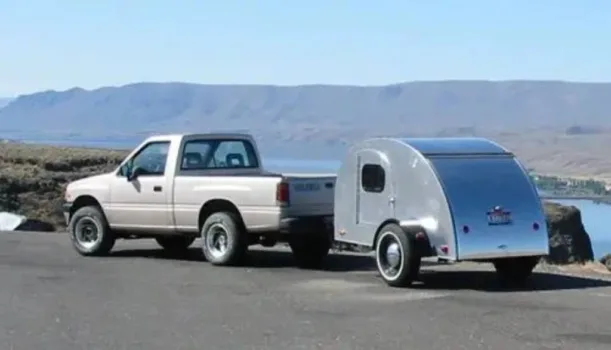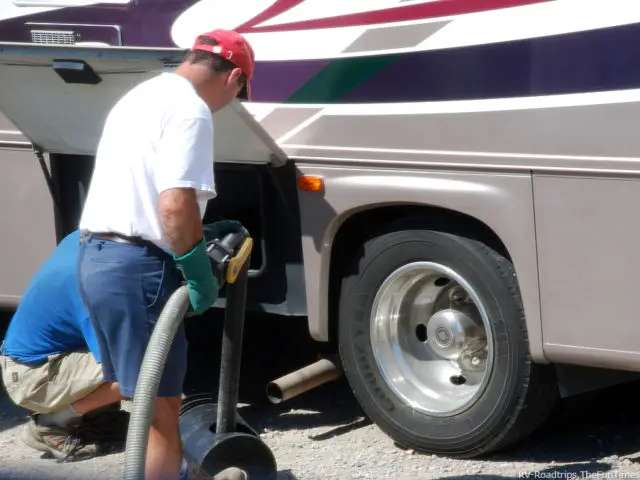
I got to wondering — in a perfect world — what my next RV would be. I came up with 2 different types of recreational vehicles.
To qualify my 2 choices, I should say that I’m a hands-on kind of guy. Fixing, adjusting, modifying to suit our needs are the norm for my wife and I.
That said, my top 2 choices for our next RV would be:
- a 25-foot fifth wheel trailer
- a teardrop trailer
Now, for the “why” I chose each of these RVs…
The serious downturn in the housing market has placed the McMansion out of favor with many home buyers.
This fate may have an effect on the RV industry as well.
With fuel prices where they are, it’s easy to see that the “less is more” theory can be applied to RVs as well.
Such is why I’ve chosen the following as our recreational vehicles of choice.
An RV For Full-Timing

My first choice would be for an RV to become our only residence — full time. My wife and I aren’t new to the concept of full timing. We’ve “gone mobile” twice since 1995 and hope to do it again when I retire.
With a total of 3+ years of full time RVing under our belt, we learned many things along the way. The next time will be more cost-effective and user-friendly.
A few years back, we owned a 10-year-old Fleetwood Prowler 24-foot fifth wheel trailer. We bought it structurally sound and did a cosmetic makeover to the interior. With a modest $5,000 investment, we had a great vacation RV that worked perfectly for us. Many times since, we’ve stated that was the best RV of all the ones we’ve owned.
In my opinion, at least for us, the perfect full time RV would be a used 25-foot lightweight fifth wheel trailer with one modest sized living room slide out. We would choose a bunkhouse model, even though it would only be the two of us.
Now for the why:
1. Used is cheaper (by a huge percentage). A 5-year-old trailer will be 50% off new, and 10 years old will be pennies on the dollar compared to new.
2. With no running gear, buy a set of tires and it’s like new. Worst-case scenario, you might have to replace the refrigerator if it doesn’t work properly.
3. You can remodel a used RV trailer to make it fit your needs and give it an updated look.
For example, my wife dislikes the standard dinette that seems to plague most RVs. She is immediately on me to remove them. Each dinette in our past was replaced with a cozy table for two — saving valuable floor space. (And it just looks better.)
Carpeting is another sore spot. We have pets — a small dog and a cat. We travel very well with our furry little kids, but they do have accidents. A rug can be thrown in the wash, carpeting just looks bad in short order. So, out it goes and laminate flooring (or vinyl) comes in.
4. The reason for the bunkhouse is “laundry room”. Just tear out the bunks, and install a stacked washer and dryer. The additional room becomes hamper space, extra closet space, a spot for the mop, broom and dustpan. Without carpeting you don’t need a vacuum cleaner. Maximum efficiency, minimum size.
5. A 25-foot fifth wheel trailer in most cases can be towed by a five/eights ton pickup. An F150, or GMC 1500 can be used to tow such a trailer. This, with the right engine, will also enable you use E-85 fuel instead of gas. Plus, you will get a better ride and better mileage than a 1-ton pulling a 38-foot McMansion on wheels.
6. Maneuverability. Smaller is always better for getting into tight spaces.
There, you’ve just saved yourself up to about $90,000. A $10,000 investment in a used RV trailer, over a rolling luxury condo on wheels that costs about $100,000.
A Cross-Country Traveler

My second choice in RVs would be for the trip I hope to make one day.
I’ve always wanted to travel across Canada and into Alaska. A wandering of sorts with no timetable. As I don’t expect to hit the Power Ball Lottery anytime soon, it would be on a modest budget.
Therefore, my second RV of choice would be a teardrop trailer.
Naturally my wife and I have different ideas when it comes to traveling in this manner. I would be heading out on this journey solo, as Mary is not the least bit interested in this level of downsizing.
I would imagine building my small compact dwelling from scratch. Following the accepted standard size, I would construct it 5 feet wide and 10 feet long. And it would have a clam shell rear hatch that opened to reveal a compact, but functional, kitchen.
There are many design options available on the Internet. (Check out this Kuffel Creek Teardrop Trailer Plans directory!) Or, you could just buy a shell to outfit it as you feel appropriate.
Being somewhat of a tech-no-nut, I would install:
- extra battery capacity
- a solar panel
- a water system
- a gas refrigerator

Admittedly I like my comfort items, too. My tow rig would be a mini-SUV rigged with HF/VHF ham radio, as I would plan on being out of cell phone range more often than not.
With a portable shower, cleanliness could be maintained no matter how far from civilization I wandered. “Bye Dear, I’ll see you in the fall… I’m off to Alaska.”
It’s an interesting dream, but actually I’m not that well suited for a solitary journey of that magnitude. Mary and I get along way too well together. I would have to up-size this rig a bit and take her along.
The T@B Micro-Light would be a good compromise. Large enough for both of us, but small enough to be efficient. I would still choose the clam shell model because cooking belongs outdoors when you’re camping. Pulled with a smaller pickup like a Toyota Tacoma or Ford Ranger, it would still maintain fuel efficiency unreachable by larger trailers or motorhomes.



